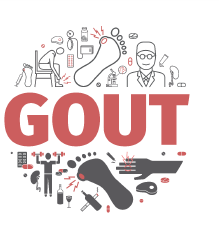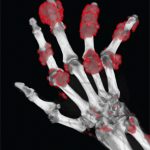
Prokopenko Oleg / shutterstock.com
A larger proportion of patients with gout had a therapeutic response at six months when treated with methotrexate and pegloticase than with pegloticase alone, according to results from the multi-center, open-label MIRROR (methotrexate to increase response rates in patients with uncontrolled gout receiving KRYSTEXXA) study, recently published in the Journal of Rheumatology.1
The MIRROR study included 14 patients with uncontrolled gout who received 15 mg weekly of oral methotrexate and 1 mg daily of folic acid starting four weeks before and continuing throughout the pegloticase treatment course.
Background
Gout affects approximately 9.2 million people in the U.S. Initial treatments with oral urate-lowering therapies are often ineffective, according to the study researchers. Some patients cannot tolerate or do not respond to these types of medications, leaving serum uric acid (sUA) levels at 6 mg/dL or higher and with continued urate deposition. Patients with persistently elevated sUA frequently have a lower quality of life and more disability.
In these patients with uncontrolled gout, pegloticase given by intravenous infusion every two weeks provides a final treatment option.
Although pegloticase is effective at lowering sUA by converting uric acid to allantoin, previous studies have shown that only 42% of patients can maintain an sUA below 6.0 mg/dL at six months of therapy. Twenty-six percent of patients also experience infusion-related reactions, thought to be due to the development of anti-drug antibodies, which also hasten pegloticase clearance and reduce efficacy.2,3 This has led some physicians to prescribe pegloticase along with immunomodulators, including methotrexate, azathioprine, leflunomide, mycophenolate and cyclosporine A, to help prevent the development of anti-drug antibodies and to lengthen the time period during which pegloticase is effective.
Studies focused on pegloticase with immunomodulators have had differing doses, routes and schedules, making it difficult to determine firm clinical recommendations. However, multiple case series have shown significant improvement with a regimen of methotrexate and pegloticase. Methotrexate and pegloticase responders were 100% in two series and 80% in another, all higher than the 42% rate seen with pegloticase alone in the previously published clinical trials, according to the MIRROR researchers.
The current study focused on the efficacy and safety of pegloticase and methotrexate used for uncontrolled gout, defined as an sUA of 6 mg/dL or higher before the study began and one or more of the following: an inability to maintain sUA of less than 6 mg/dL on other therapies, intolerance to their current urate-lowering therapy or the existence of functionally limiting tophaceous deposits.
Note: Horizon Therapeutics, the maker of pegloticase, supported the study.
Study Details
The study took place at six sites across the U.S. and included men and women between 18 and 65 years old. For four weeks before the study began, which was considered the run-in period, patients received 15 mg per week of oral methotrexate and 1 mg daily of folic acid. To determine the methotrexate dosage, study researchers used previous evidence that recommended a dose of 10 to 15 mg per week. During the treatment period, patients received oral methotrexate weekly, folic acid daily and 8 mg of intravenous pegloticase every two weeks.
One week before the study’s official start, patients began a gout flare prophylaxis regimen that included colchicine and/or non-steroidal anti-inflammatory drugs and/or low-dose prednisone (i.e., less than 10 mg/day). Patients continued the flare prophylaxis for most of the six-month period. They also received a standard infusion reaction prophylaxis of oral fexofenadine, acetaminophen and intravenous glucocorticoids.
The researchers used a pegloticase uric acid monitoring protocol to minimize the occurrence of infusion reactions.
All patients received pegloticase and methotrexate through the end of the treatment period, for up to 52 weeks, with follow-
up visits occurring every two weeks. Follow-up visits included adverse event assessment, concomitant medication update, blood and urine sample collection, and a physical exam.
The primary outcome was the proportion of responders—patients who achieved an sUA of less than 6 mg/dL for more than 80% of the time at six months.
Examining the Results
Seventeen patients were screened for study inclusion, and 14 ultimately received at least one dose of pegloticase. Eleven patients completed pegloticase and methotrexate treatment for 24 weeks. All patients were men, with a mean age of 49.3 years; 11 of the 14 patients were white.
On day 1, the mean sUA was 9.2 mg/dL; 12 of 14 patients had visible tophi.
At six months, 11 patients (78.6%) were responders, with three patients meeting stopping criteria. For these three patients, loss of response occurred after two infusions, three infusions and five infusions (one patient each).
The mean total methotrexate dosage was 64.4 mg during the methotrexate run-in period, with no dosage reduction occurring.
Before therapy with pegloticase and methotrexate, patients had a mean of 6.4 joints affected by tophi. By the last assessment, the number had been reduced to a mean of 2.6 joints.
The adverse events seen most frequently were gout flare, nausea and abdominal discomfort during the run-in period. During the co-treatment, all patients had at least one adverse event, including gout flare (85.7%; the flares were mild to moderate in most patients), diarrhea (21.4%) and upper respiratory tract infection (21.4%). There were no major adverse cardiovascular events.
Thirteen of 14 patients had stable or improved kidney function. No increases occurred in liver function tests.
Clinical Implications
The results of the MIRROR study demonstrate the need for a controlled trial to help confirm the findings are not confounded by differences in steroid prophylactic agents, according to the study researchers. In fact, such a trial is currently underway with the MIRROR RCT, according to according to John K. Botson, MD, a rheumatologist with Orthopedic Physicians Alaska in Anchorage, and the lead author of the MIRROR open-label study.
Topline results from MIRROR RCT were reported in October 2021: Primary endpoints were met, and 71% of patients with uncontrolled gout achieved a complete response rate using pegloticase with immunomodulator methotrexate.4

Dr. Botson
Dr. Botson is also involved with other research in this area, including the AGILE trial to evaluate a shorter infusion duration for pegloticase prescribed with methotrexate; the FORWARD trial to evaluate pegloticase dosing options given every four weeks; and the ADVANCE trial to evaluate pegloticase with methotrexate to treat those with previously developed anti-drug antibodies on pegloticase monotherapy.
Michael Toprover, MD, rheumatologist and assistant professor of medicine at NYU Langone Health in New York City, says the MIRROR open-label study is an important stepping stone to support adding an immunomodulator to decrease the risk of anti-pegloticase antibody formation and help patients. He is curious to see the results of a larger trial, particularly with the risks associated with immunomodulatory therapies.
“More robust data need to be collected on the overall safety of these medications in gout patients,” Dr. Toprover says.
He would like to see the results from a randomized trial fall in line with the open-label study and find out how the co-treatment fares in Black and Hispanic patients, to ensure that any effects are generalizable beyond white patients.
An improved response from pegloticase with an immunomodulator, such as methotrexate, can help patients who are struggling with disability and a decrease in their quality of life. “For these patients, pegloticase is the last line of treatment for a painful and damaging chronic disease,” Dr. Botson says. “The better we can make this medication work, the better it’s going to be for our patients.”
Vanessa Caceres is a medical writer in Bradenton, Fla.
References
- Botson JK, Tesser JRP, Bennett R, et al. Pegloticase in combination with methotrexate in patients with uncontrolled gout: A multicenter, open-label study (MIRROR). J Rheumatol. 2021 May;48(5):767–774.
- Sundy JS, Baraf HSB, Yood RA, et al. Efficacy and tolerability of pegloticase for the treatment of chronic gout in patients refractory to conventional treatment: Two randomized controlled trials. JAMA. 2011 Aug 17;306(7):711–720.
- Keenan RT, Baraf HSB, LaMoreaux B. Use of pre-infusion serum uric acid levels as a biomarker for infusion reaction risk in patients on pegloticase. Rheumatol Ther. 2019 Jun;
6(2):299–304.
- Press release. Horizon Therapeutics. 2021 Oct 25.



